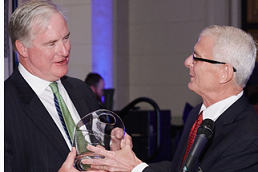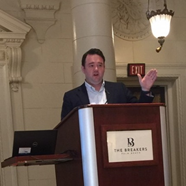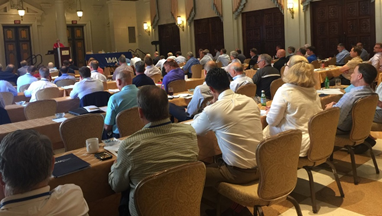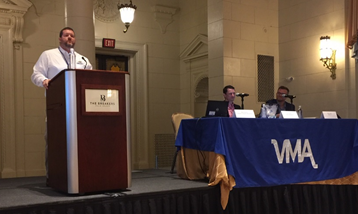Annual Meeting: Sandler Celebrated, New VMA Leaders Announced
Bill Sandler spent much of the 81st VMA/VRC annual meeting being surprised and honored for his 42 years of service to the association and the valve industry.
#maintenance-repair #VMAnews
Another surprise award recipient this year was the 2019 Person of the Year Jim Walther, KITZ Corporation. Walter has been in the industry many years including helping to plan many annual meetings and serving on the nominating committee.
NEW LEADERSHIP
Heading up that search committee was Bryan Burns, incoming chairman of the association. Burns is president and CEO of DeZURIK. Other elected officers approved at the 81st annual meeting included:
- Vice-Chair: Brad Ellis, senior vice president of Crane Co.
- Program Chairman: Arie Bregman, vice president and general manager of DFT, Inc.
- David Hughes, director of Global Accounts–Final Control (a business unit within Emerson Automation Solutions), became immediate past chairman of the board.
An important part of each annual meeting are the speakers invited to share their thoughts on today’s current valve industry issues. This year, the board and attendees heard experts cover a wide range of topics including the U.S. economic outlook, cybersecurity and the U.S.-Mexico-Canada trade agreement.
U.S. OUTLOOK 2019-2020
For the rest of 2019 into 2020, “fasten your seatbelts,” according to Beth Ann Bovino, chief U.S. economist/managing director for global economics and research at S&P Global Ratings.
The current recovery from the 2008 recession is the longest economic expansion in U.S. history, Bovino said, and it is still going. She cited several factors that account for the ongoing situation.
- Consumers still have high confidence in the economy. Private demand is robust, and businesses are hiring.
- Wages have finally increased, so consumers are opening their wallets.
- The housing market is currently stable.
- Manufacturing operations and employment are returning to the U.S.
- Real GDP growth will likely slow to around 2.5% this year and continue near its current trend for 2020.
Consumer debt continues to climb in dollar amount, but is falling as a percent of disposable income, down below 90% from a high of about 120% in 2008-2009. At the same time, the debt carried by countries, including the U.S., looks as if it will continue to rise as a percent of GDP well into this century if current policies continue.
Bovino placed the risk of recession during the next 12 months at 30–35% influenced by various economic headwinds including:
- Trade tensions turning to trade war.
- Policy risks in the U.S. and abroad, including the U.S. debt ceiling, Brexit and Iran.
- Possible stalling of non-residential investment.
- Core inflation moving closer to the Federal Reserve’s 2% target.
WALL STREET’S VIEW
Halloran gave examples of characteristics that investors like to see in companies, especially late in the expansion cycle. Recurring/aftermarket/service/software revenue provides for growth and increased margins even in a low-growth environment. Cost-reduction programs aimed at simplifying processes can benefit both manufacturing and the supply chain. Best-in-class companies consistently spend a high percentage (3–5%) on research and development and similar activities during both good times and bad.
U.S.-MEXICO-CANADA AGREEMENT (USMCA)
The USMCA agreement, signed on Nov. 30, 2018, remains in many ways the same as the North American Free Trade Agreement (NAFTA) that preceded it, said Christopher Wilson, deputy director at Wilson Center’s Mexico Institute. However, difference do exist including:
- Auto Rules of Origin: 75% of automobile content must be made in North America; 40–45% must be made by workers earning at least $16 per hour
- Sunset Clause: The USMCA automatically expires in 16 years if no action is taken. However, it allows for a review process every six years and a consensus of the participants can extend it for 16 years.
- Dispute Resolution: The agreement places more limitations on U.S.-Mexico investor-state dispute settlement (ISDS), a mechanism for investors suing a country, but maintains stronger protections for energy, telecommunications and transportation sectors. It removed the U.S.-Canada ISDS.
- Labor and Environment: Provisions for labor and environment are now part of the core agreement and subject to dispute resolution. Mexico must change domestic law to ensure fair procedures for the election of union representatives.
- Intellectual Property: The agreement enhances copyright and trademark protections and allows 10 years protection for biologic drug. It also provides safe harbor for internet service providers (protection from copyright liability for the actions of their users).
- Data Storage: The agreement places a prohibition on most local data storage requirements.
Wilson told attendees that the USMCA passage would be passed by Congress before years end, but the Trump impeachment inquiry [news of the inquiry broke just as the annual meeting started] could result in further delays.
CYBERSECURITY
The top cyberattack concerns among executives are business interruption, damage to reputation, damage to data or software and breach of customer information, said Kevin Kemerer, president of Precision Pump & Valve Service. For detail on perceived risks, he referred attendees to the 2019 Global Cyber Risk Perception Survey from Marsh and Microsoft.
When considering cyber threats, Kemerer advised thinking “when it happens” not “if it happens.” Ron Veillon, vice president and CIO, Bray International, described five pillars of cybersecurity defense and steps companies can take to support those pillars:
- Risk Management: Basics such as email filtering and training employees in security policies can help manage risk. Also, periodic testing for physical and cyber penetration vulnerability can reveal areas of weakness that need to be addressed.
- Identity and Access Management: Multi-factor authentication can be implemented for all users to help control access.
- Device Health: To ensure that only healthy devices can access corporate data, software needs to be kept up to date. Endpoint security protects devices connected to the network.
- Data & Telemetry: Real-time monitoring detects anomalies in the system. Regularly scheduled backups allow recovery when data integrity is compromised.
- Information Protection: Encryption of data and emails protects sensitive and confidential data. Data loss prevention monitoring safeguards intellectual property.
Cybersecurity threats are varied and growing, said Shane Velan, vice president, transformation office and IT at Velan Inc.. He gave phishing as an example. Phishing attacks manipulate individuals in order to obtain data, payment or access. Often a phishing attack arrives as an innocent-looking email. To put the problem in perspective, he said that about 156 million phishing messages are sent daily. Of these, 16 million make it into inboxes. Eight million are opened and in 0.8 million, the recipient clicks the link. This results in about 80,000 incidents of compromised systems or data every day.
CHANGES TO DISTRIBUTION
Following in the footsteps of retail, business-to-business sales is also heading into e-commerce as the new normal. Large players in e-commerce (notably Amazon, but also big-box retailers) are causing disruption in how businesses purchase and receive goods.
The generational shift as older workers retire means a greater and greater proportion of the workforce will be “digital natives” who have grown up with computers and the internet. They expect the convenience of online ordering at work the same as they have at home and will welcome the advent of artificial intelligence aiding them in selecting what they need.
2020 ANNUAL MEETING
VMA’s next Annual Meeting takes place Sept. 9-11 at the Ritz-Carlton Bacara in Santa Barbara, CA. The meeting is open only to VMA and VRC (Valve Repair Council) members. Membership information is available at www.VMA.org.
Barbara Donohue is the web editor at VALVE Magazine. Also contributing to this article was Genilee Parente, managing editor of VALVE Magazine.
RELATED CONTENT
-
Ball Valve Repair 101
From time to time, we are re-posting well-received or particularly valuable articles that have previously run on VALVEMagazine.com so that those who might have missed them will be able to catch up on the best of the best.
-
Creating a Standard for Severe Service Valves
Severe service valves are offered in several standard designs, including non-return, isolation and control types.
-
Isolation Valves for High-solids Severe Service
Understanding suspended solids and their effect on equipment is critical in choosing isolation valves for slurry service.











 Unloading large gate valve.jpg;maxWidth=214)


